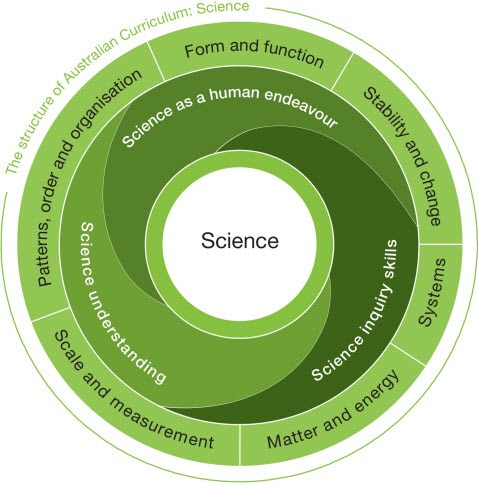Key ideas
In the Australian Curriculum: Science, there are six key ideas that represent key aspects of a scientific view of the world and bridge knowledge and understanding across the disciplines of science, as shown Figure 1 below. These are embedded within each year level description and guide the teaching/learning emphasis for the relevant year level.

Figure 1: Key ideas of the science curriculum
These key ideas are designed to support the coherence and developmental sequence of science knowledge within and across year levels. The key ideas frame the development of concepts in the science understandingstrand, support key aspects of the science inquiry skills strand and contribute to developing students’ appreciation of the nature of science.
The six key ideas that frame the Australian Curriculum: Science are:
Patterns, order and organisation
An important aspect of science is recognising patterns in the world around us, and ordering and organising phenomena at different scales. As students progress from Foundation to Year 10, they build skills and understanding that will help them to observe and describe patterns at different scales, and develop and use classifications to organise events and phenomena and make predictions. Classifying objects and events into groups (such as solid/liquid/gas or living/non-living) and developing criteria for those groupings relies on making observations and identifying patterns of similarity and difference.
As students progress through the primary years, they become more proficient in identifying and describing the relationships that underpin patterns, including cause and effect. Students increasingly recognise that scale plays an important role in the observation of patterns; some patterns may only be evident at certain time and spatial scales. For example, the pattern of day and night is not evident over the time scale of an hour.
Form and function
Many aspects of science are concerned with the relationships between form (the nature or make-up of an aspect of an object or organism) and function (the use of that aspect).
As students progress from Foundation to Year 10, they see that the functions of both living and non-living objects rely on their forms. Their understanding of forms such as the features of living things or the nature of a range of materials, and their related functions or uses, is initially based on observable behaviours and physical properties. In later years, students recognise that function frequently relies on form and that this relationship can be examined at many scales. They apply an understanding of microscopic and atomic structures, interactions of force and flows of energy and matter to describe relationships between form and function.
Stability and change
Many areas of science involve the recognition, description and prediction of stability and change. Early in their schooling, students recognise that in their observations of the world around them, some properties and phenomena appear to remain stable or constant over time, whereas others change.
As they progress from Foundation to Year 10, they also recognise that phenomena (such as properties of objects and relationships between living things) can appear to be stable at one spatial or time scale, but at a larger or smaller scale may be seen to be changing. They begin to appreciate that stability can be the result of competing, but balanced forces. Students become increasingly adept at quantifying change through measurement and looking for patterns of change by representing and analysing data in tables or graphs.
Scale and measurement
Quantification of time and spatial scale is critical to the development of science understanding as it enables the comparison of observations. Students often find it difficult to work with scales that are outside their everyday experience – these include the huge distances in space, the incredibly small size of atoms and the slow processes that occur over geological time.
As students progress from Foundation to Year 10, their understanding of relative sizes and rates of change develops and they are able to conceptualise events and phenomena at a wider range of scales. They progress from working with scales related to their everyday experiences and comparing events and phenomena using relative language (such as 'bigger' or 'faster') and informal measurement, to working with scales beyond human experience and quantifying magnitudes, rates of change and comparisons using formal units of measurement.
Matter and energy
Many aspects of science involve identifying, describing and measuring transfers of energy and/or matter. As students progress through Foundation to Year 10, they become increasingly able to explain phenomena in terms of the flow of matter and energy.
Initially, students focus on direct experience and observation of phenomena and materials. They are introduced to the ways in which objects and living things change and begin to recognise the role of energy and matter in these changes. In later years, they are introduced to more abstract notions of particles, forces and energy transfer and transformation. They use these understandings to describe and model phenomena and processes involving matter and energy.
Systems
Science frequently involves thinking, modelling and analysing in terms of systems in order to understand, explain and predict events and phenomena. As students progress through Foundation to Year 10, they explore, describe and analyse increasingly complex systems.
Initially, students identify the observable components of a clearly identified ‘whole’ such as features of plants and animals and parts of mixtures. Over Years 3 to 6, they learn to identify and describe relationships between components within simple systems, and they begin to appreciate that components within living and non-living systems are interdependent. In Years 7 to 10, they are introduced to the processes and underlying phenomena that structure systems such as ecosystems, body systems and the carbon cycle. They recognise that within systems, interactions between components can involve forces and changes acting in opposing directions and that for a system to be in a steady state, these factors need to be in a state of balance or equilibrium. They are increasingly aware that systems can exist as components within larger systems, and that one important part of thinking about systems is identifying boundaries, inputs and outputs.